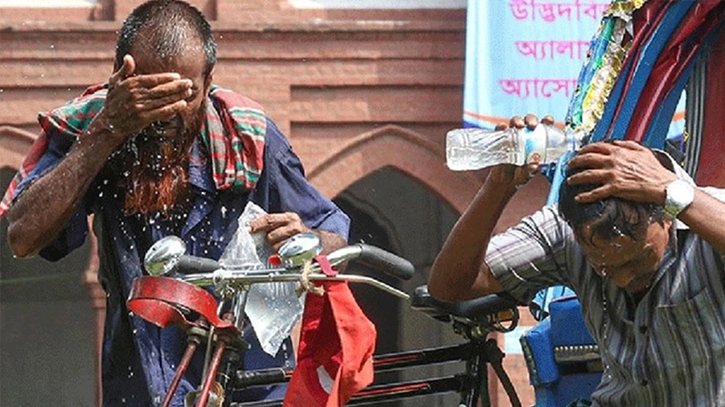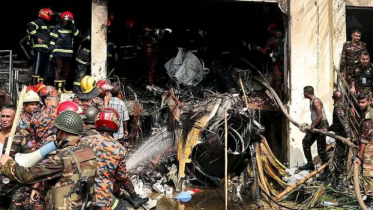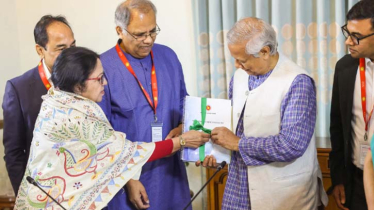
Photo : Collected
Bangladesh is experiencing the highest heatwave in its history. This heatwave is longer than any other recorded in the past. Consequently, public life has been disrupted across the country, including the capital city Dhaka. As a result, people are suffering from various diseases, including heat stroke. Meanwhile, two people died in Pabna and Chuadanga on Saturday.
Meteorologists and environmentalists have said that the country’s environment has been affected by both natural and man-made causes at various times. On one hand, the amount of vegetation has decreased compared to the requirement, while on the other hand, the temperature is continuously increasing due to the rise in the number of industrial plants.
According to the data from the meteorological office, the temperature in the country has been increasing since April 10. On Saturday, the maximum temperature in Jashore rose to 42.6 degrees Celsius. On that day, the temperature in the capital Dhaka was 40.4 degrees Celsius. However, in reality, the temperature has been felt as high as 45-50 degrees Celsius.
Kazi Jebunnesa, a Meteorologist at the Bangladesh Meteorological Department, told The Daily Messenger, “A severe heatwave has been ongoing in the country since the day of Eid. Since April 13, a ‘heat alert’ warning message has been issued to the countrymen to protect them from this heatwave.”
She also mentioned that last year there was also severe temperature all over the country, including Dhaka. However, this time the heatwave started from March 31. On Saturday, it rose to 42.6 degrees Celsius, and the temperature in Dhaka stood at 40.4 degrees Celsius, the highest this year. This high temperature is expected to persist throughout this month.
Not only in Bangladesh, but the heatwave has also spread to different districts of India. Citing the Alipur Meteorological Department of West Bengal, the country’s Anandabazar newspaper reported that a very intense heatwave would continue in South Bengal on Sunday. The maximum temperature in South Bengal crossed 44 degrees Celsius on Friday. However, the maximum temperature is expected to exceed 45 degrees Celsius.
Due to this, a red warning for a heatwave has been issued in six districts of South Bengal. These six districts are East Medinipur, West Medinipur, Bankura, Jhargram, Birbhum, and West Burdwan. Apart from this, a severe heatwave warning has also been issued for Kolkata, Hooghly, Howrah, 24 Parganas, Nadia, Murshidabad, Purulia, and East Burdwan.
Environmentalists have said that due to climate change, Bangladesh is becoming extremely hot. Climate change is happening for two reasons: one being global, and the other is the local factor. Regarding the local causes, they said air-tight high-rise buildings, structures, vehicles, and population density, along with various types of pollution and filling of rivers and reservoirs, are causing the temperature to feel high in urban areas.
The indiscriminate felling of trees, destruction of the natural environment, and construction of structures and facilities for urbanization are increasingly turning urban areas into heat islands. Mainly because of buildings, concrete, asphalt, and human activities, the temperature in cities is higher than in villages.
Ahmad Kamruzzaman Majumdar, Joint Secretary of Bangladesh Paribesh Andolon (BAPA) and Dean of the Science Faculty at Stamford University Bangladesh, told The Daily Messenger that air pollution is increasing in Dhaka city. As greenery decreases, the temperature is also increasing.
He said, “The average temperature of Dhaka has increased by about 4 degrees Celsius in the last 20 years. Unplanned urbanization, lack of coordination between various agencies involved in urban management and services, and errors or deficiencies in environmental management are more responsible than climate change for rising temperatures.”
“The temperature of Dhaka city is increasing due to these three reasons - global, regional, and local. Global factors include carbon emissions from burning fossil fuels and the destruction of forests, including the Amazon. Although we are not largely responsible for this, it is affecting Bangladesh as well,” he added.
According to environmentalists, the reason for the increase in temperature in Dhaka is the depletion of reservoirs. The reservoirs or ponds in Dhaka city are decreasing at an alarming rate. Reservoirs are being filled with sand instead of soil. This is also one of the reasons for the increase in temperature.
Besides, the overpopulation of Dhaka is contributing to the rise in temperature. The human body has its own temperature, called metabolic heating. This temperature is 100 watts per person. That is, if there are a large number of people in a place, the temperature will be relatively high because of the people alone.
Temperature is also rising due to cooking and waste burning. In Dhaka, about 20 lakh families spend at least three hours cooking on 20 lakh burners every day. And due to the burning of plastic waste everywhere, various toxic gases and harmful micro-plastics are polluting the air. These plastic particles floating in the air also retain heat.
Apart from this, excess traffic and congestion problems in the capital are contributing to the rise in temperature. Due to traffic jams, vehicles have to stand on the road for hours with their engines running. Also, the city’s paved roads heat up during the day and release heat at night, warming the environment. The environment is also heating up due to the additional use of glass and AC in multi-storied buildings.
Meanwhile, due to excessive heat, women, men, and children are suffering from various diseases.
Dr. Mostak Hossain, Adviser of Epidemiology at the Institute of Disease Control and Research (IEDCR), told The Daily Messenger that there are two types of pollution due to heat. One is food and water pollution, and the other is air pollution. Diarrhea, typhoid, jaundice, and other diseases are caused due to food and water pollution. And because of air pollution, coughs and colds are happening. Cold-fever and pneumonia are increasing in children.
Dr Shahidullah Sikder, a professor in the Dermatology Department of Bangabandhu Sheikh Mujib Medical University, told The Daily Messenger, “Due to the low humidity in the air caused by the ongoing heatwave, the skin is drying up with chapped lips. Many patients have come who are losing consciousness due to heat intolerance. Many of them have suffered from minor ‘heat stroke’.”
Messenger/Fameema








